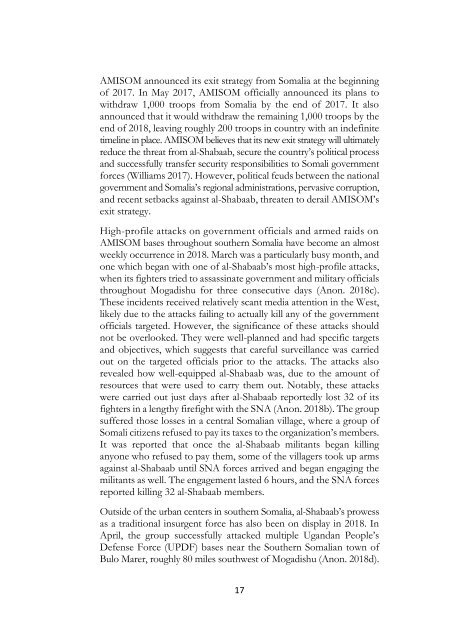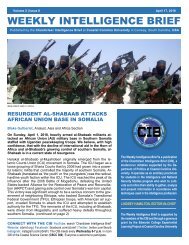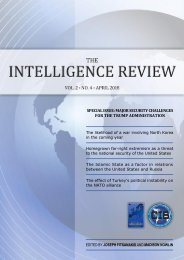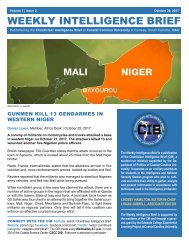The Intelligence Review | volume 3 | issue 5 |
This volume is the product of a collaboration between the European Intelligence Academy (EIA) and the Chanticleer Intelligence Brief (CIB), a pre-professional body supported by the Department of Politics at Coastal Carolina University in Conway, South Carolina, United States. Six CIB analysts tackle some of the most pressing and timely questions confronting intelligence observers today. Topics in this issue include the current and projected strength of the al-Shabaab militant group in East Africa, the future of the Iran nuclear agreement, and the current state of Mexico’s drug cartels. The issue also contains an analysis of the rising tension between the European Union and the government of Poland, as well as of the complex relationship between the United States and Cuba. The compendium concludes with an eye-opening report on the state of Middle Eastern linguistics in the United States Intelligence Community in the post-9/11 era.
This volume is the product of a collaboration between the European Intelligence Academy (EIA) and the Chanticleer Intelligence Brief (CIB), a pre-professional body supported by the Department of Politics at Coastal Carolina University in Conway, South Carolina, United States. Six CIB analysts tackle some of the most pressing and timely questions confronting intelligence observers today. Topics in this issue include the current and projected strength of the al-Shabaab militant group in East Africa, the future of the Iran nuclear agreement, and the current state of Mexico’s drug cartels. The issue also contains an analysis of the rising tension between the European Union and the government of Poland, as well as of the complex relationship between the United States and Cuba. The compendium concludes with an eye-opening report on the state of Middle Eastern linguistics in the United States Intelligence Community in the post-9/11 era.
You also want an ePaper? Increase the reach of your titles
YUMPU automatically turns print PDFs into web optimized ePapers that Google loves.
AMISOM announced its exit strategy from Somalia at the beginning<br />
of 2017. In May 2017, AMISOM officially announced its plans to<br />
withdraw 1,000 troops from Somalia by the end of 2017. It also<br />
announced that it would withdraw the remaining 1,000 troops by the<br />
end of 2018, leaving roughly 200 troops in country with an indefinite<br />
timeline in place. AMISOM believes that its new exit strategy will ultimately<br />
reduce the threat from al-Shabaab, secure the country’s political process<br />
and successfully transfer security responsibilities to Somali government<br />
forces (Williams 2017). However, political feuds between the national<br />
government and Somalia’s regional administrations, pervasive corruption,<br />
and recent setbacks against al-Shabaab, threaten to derail AMISOM’s<br />
exit strategy.<br />
High-profile attacks on government officials and armed raids on<br />
AMISOM bases throughout southern Somalia have become an almost<br />
weekly occurrence in 2018. March was a particularly busy month, and<br />
one which began with one of al-Shabaab’s most high-profile attacks,<br />
when its fighters tried to assassinate government and military officials<br />
throughout Mogadishu for three consecutive days (Anon. 2018c).<br />
<strong>The</strong>se incidents received relatively scant media attention in the West,<br />
likely due to the attacks failing to actually kill any of the government<br />
officials targeted. However, the significance of these attacks should<br />
not be overlooked. <strong>The</strong>y were well-planned and had specific targets<br />
and objectives, which suggests that careful surveillance was carried<br />
out on the targeted officials prior to the attacks. <strong>The</strong> attacks also<br />
revealed how well-equipped al-Shabaab was, due to the amount of<br />
resources that were used to carry them out. Notably, these attacks<br />
were carried out just days after al-Shabaab reportedly lost 32 of its<br />
fighters in a lengthy firefight with the SNA (Anon. 2018b). <strong>The</strong> group<br />
suffered those losses in a central Somalian village, where a group of<br />
Somali citizens refused to pay its taxes to the organization’s members.<br />
It was reported that once the al-Shabaab militants began killing<br />
anyone who refused to pay them, some of the villagers took up arms<br />
against al-Shabaab until SNA forces arrived and began engaging the<br />
militants as well. <strong>The</strong> engagement lasted 6 hours, and the SNA forces<br />
reported killing 32 al-Shabaab members.<br />
Outside of the urban centers in southern Somalia, al-Shabaab’s prowess<br />
as a traditional insurgent force has also been on display in 2018. In<br />
April, the group successfully attacked multiple Ugandan People’s<br />
Defense Force (UPDF) bases near the Southern Somalian town of<br />
Bulo Marer, roughly 80 miles southwest of Mogadishu (Anon. 2018d).<br />
17

















